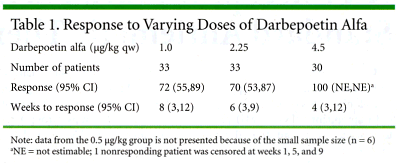Darbepoetin Alfa Extends Benefits of Erythropoietic Therapy to Patients With Chronic Anemia
COLUMBIA, South Carolina-A dose escalation trial of darbepoetin alfa (Aranesp) found the new erythropoietic agent can boost hemoglobin rates in most cancer patients with chronic anemia, a group not usually treated with erythropoietic therapy (ASCO abstract 1465).
COLUMBIA, South CarolinaA dose escalation trial of darbepoetin alfa (Aranesp) found the new erythropoietic agent can boost hemoglobin rates in most cancer patients with chronic anemia, a group not usually treated with erythropoietic therapy (ASCO abstract 1465).
The multicenter investigation led by Robert E. Smith, MD, president of South Carolina Oncology Associates in Columbia, focused on patients who were not receiving concomitant chemotherapy or radiation. The sole erythropoietic agent approved for treating anemia in cancer patients, epoetin alfa (Procrit), is indicated for patients undergoing chemotherapy for nonmyeloid malignancies.
Yet anemia is common in patients who are not receiving chemotherapy or radiation treatments, according to Dr. Smith and his co-investigators. Previous studies suggest anemia could be the result of reduced red blood cell survival, relative deficiency of endogenous erythropoietin, or blunted erythropoietic response.
Dose Escalation
All 188 patients in the pilot study had hemoglobin levels of 11 g/dL or less at the outset. Their cancers included breast, prostate, gastrointestinal, lung, gynecologic, and other primary tumors. None of the patients had received chemotherapy or been treated with erythropoietic therapy in the 8 weeks prior to the trial, but patients may have had up to two red blood cell transfusions within 4 weeks of enrollment. Participants also could not expect to receive chemotherapy or external beam radiotherapy within 16 weeks of enrollment.
The first 102 patients were injected weekly with darbepoetin alfa in sequential doses of 0.5, 1.0, 2.25, or 4.5 µg/kg for the 12 weeks of the study. Hematopoietic response was defined as an increase in hemoglobin of 2 g/dL or greater or reaching a hemoglobin level of 12 g/dL or more. The hematopoietic response rate hovered around 70% for the 1.0 and 2.25 µg/kg doses, and reached 100% at the top dose (see Table 1). "I don’t think anything has shown a 100% response rate," Dr. Smith said, referring to previous studies.

Frequency of Administration
The investigators’ real interest, however, was to determine whether they could give darbepoetin alfa less frequently. The new agent has a longer serum half-life than epoetin alfa and may be able to be administered on a schedule that is less frequent. Consequently, another group of patients was randomized into four cohorts:
- 6.75 µg/kg of darbepoetin alfa every 3 weeks;
- 6.75 µg/kg every 4 weeks;
- 10 µg/kg every 4 weeks;
- placebo.
Hematopoietic responses to the 3- and 4-week regimens were nearly identical at 6.75 µg/kg: 60% and 61% respectively. Among patients who received 10 µg/kg, the response rate was higher at 70%. This group also had the greatest change in hemoglobin levels from the start to the end of treatment.
Only 10% of the placebo group had a hematopoietic response. After 12 weeks these patients were allowed to switch to darbepoetin alfa, and their hemoglobin levels responded comparably to the patients in the active arms of the study.
The investigators found no safety concerns and concluded that darbepoetin alfa was well tolerated at all the dose schedules. Weekly dosing appeared to produce a faster response, they said, but increasing the dose interval did not reduce efficiency.
"Basically the good thing is that in these patients we are going to be able to dose them infrequently," Dr. Smith told ONI, adding that another trial is planned to start this summer. "We are going to dose weekly for 4 weeks, anticipating a high and rapid response, then go to every 4 week dosing."
Newsletter
Stay up to date on recent advances in the multidisciplinary approach to cancer.
Oncology Peer Review On-The-Go: Cancer-Related Fatigue Outcome Measures in Integrative Oncology
September 20th 2022Authors Dori Beeler, PhD; Shelley Wang, MD, MPH; and Viraj A. Master, MD, PhD, spoke with CancerNetwork® about a review article on cancer-related fatigue published in the journal ONCOLOGY®.